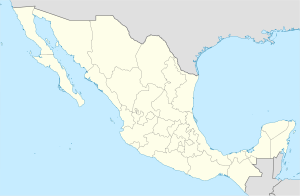Bustamante, Nuevo León facts for kids
Quick facts for kids
Bustamante
|
||
|---|---|---|
|
Municipality and town
|
||
|
||
| Country | ||
| State | Nuevo León | |
| Municipal seat | Bustamante | |
| Area | ||
| • Total | 558 km2 (215 sq mi) | |
| Elevation | 376 m (1,233 ft) | |
| Population
(2010)
|
||
| • Total | 3,773 | |
Bustamante is a town and a municipality in the state of Nuevo León, Mexico. Its full name is San Miguel de Bustamante. The municipality covers an area of 558 square kilometers. It shares borders with Lampazos de Naranjo and the state of Coahuila to the north. To the south, it borders Mina and Villaldama, Nuevo Leon. On the east, it's next to Villaldama, and on the west, it borders Mina. In 2010, about 3,773 people lived in the municipality, with most of them in Bustamante town.
Contents
Exploring Bustamante's Geography
Bustamante is located in a valley that gets plenty of water. This valley is at the start of a canyon, which is where the Sabinas River begins. The Sabinas River flows into the Salado River.
Mountains and Hills Around Bustamante
To the west of the town, you'll find the Sierra de Gomas mountains. Their highest point, Cabeza de Leon, reaches about 1,704 meters (5,591 feet) high. It's located about four miles southwest of Bustamante. East of the town, there's another mountain range called the Sierra de Lampazos, which goes up to about 1,163 meters (3,816 feet).
Bustamante's Climate
The weather in Bustamante is mostly dry, but it gets about 500 millimeters (20 inches) of rain each year. Most of this rain falls during the summer months. Summers are usually hot, while winters are mild. The coldest temperature in a year is typically around -5 °C (23 °F).
A Look at Bustamante's History
Bustamante has a rich history that goes back hundreds of years. It was founded by people who moved there to help settle the area.
How Bustamante Was Founded
In 1591, the Spanish government asked over 400 Tlaxcalan families to move to northern Mexico. Their job was to help make peace with the local Native American tribes, known as the Chichimeca. This was part of a plan to end the long-running Chichimeca War.
In 1686, sixteen Tlaxcalan families, who were descendants of those who settled near Saltillo, moved north. They founded Bustamante, which was first called San Miguel de Aguayo de la Nueva Tlaxcala. Around the same time, Franciscans (a group of religious people) set up a mission nearby. They wanted to teach Christianity to the Alazapas, a local group of nomadic Native Americans.
Mines and Community Life
In 1690, silver mines were started about eight kilometers (five miles) from Bustamante. This led to the founding of the town of Villaldama. Bustamante became important for its farming. It provided food and workers for the mines. The Alazapa people tried to resist the new Spanish and Tlaxcalan settlements. A few Alazapa survived until the 1800s, but they were later moved to Monterrey, Nuevo Leon in 1860 and became part of the larger Hispanic population.
A New Name for the Town
Bustamante got its current name in 1832. It was named after Anastasio Bustamante, who was a President of Mexico after it became independent.
Challenges and Changes Over Time
The area faced challenges from Native American raids and diseases.
- Native American Raids: On October 5, 1840, a large group of Comanche Native Americans, estimated to be 300 to 400 strong, raided the area. In Bustamante, they caused harm to people and took many animals. This was the start of about 30 years of Comanche raids that affected many communities in northern Mexico. Between 1848 and 1860, these raids led to many deaths and abductions in Bustamante. The Mexican government was not always able to help much. A local group of about 100 Tlaxcalans and Alazapa helped guard mountain passes that the Comanche might use. This was part of a larger force of 2,000 cavalry riders who patrolled the area. You can learn more about this in the Comanche-Mexico Wars article.
- Epidemics: Besides the raids, there were also serious sicknesses. In 1849, a disease called Cholera caused 197 deaths in the Bustamante region. Then, in 1856-1857, smallpox caused 429 deaths in a wider area. These sicknesses also affected the Native American raiders, and the number of raids went down a lot after the late 1850s. The last major Comanche raid happened in 1870.
Fun Things to See in Bustamante
One of the most popular places to visit in Bustamante is the amazing caves.
Exploring the Bustamante Caves
The main attraction for visitors are the Bustamante caves. These cool caves are located about two miles southwest of the town. They are a great place to explore and see natural rock formations.



